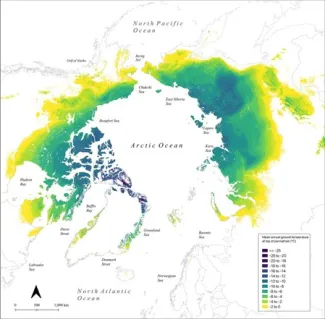Leading the way to improved understanding and communication of fundamental and cutting-edge findings on Arctic permafrost.
Permafrost is an important component of the Earth's cryosphere. It plays a key role in the global carbon cycle, as well as in the ecosystems and infrastructure in arctic and sub-arctic climate zones. Permafrost-affected soils have unique energy, water, and carbon dynamics as a result of periodic freeze–thaw cycles and the underlying continuously frozen ground. Borehole measurements show that arctic permafrost has been warming during the early 21st century. Earth system model simulations demonstrate that the carbon release from degrading permafrost due to climate warming represents an important global feedback mechanism on climate change, which affects the plausibility of achieving the temperature targets of the United Nations Framework Convention on Climate Change. By definition, permafrost encompasses ground (i.e., soil, sediments, rocks) that remains at or below 0°C for at least two consecutive years. In this overview of recent science of permafrost systems, we describe fundamental and cutting-edge findings on permafrost research for constituents, cryo-pedogenetic, hydrology, energy, and water balances, as well as snow–vegetation feedbacks and gas transport for permafrost regions. Finally, we discuss permafrost degradation and its effects on the energy, water, and carbon balances of the Arctic.
Citation: Boike J, Abramov A, Bennett KE, Kutzbach L. 2023. Arctic permafrost. Encyclopedia of Soils in the Environment (Second Edition), edited by Michael J. Goss and Margaret Oliver 5: 410–418. Oxford: Elsevier Academic Press. https://doi.org/10.1016/B978-0-12-822974-3.00141-5.
For more information, please contact:
Katrina Bennett
kbennett@lanl.gov

